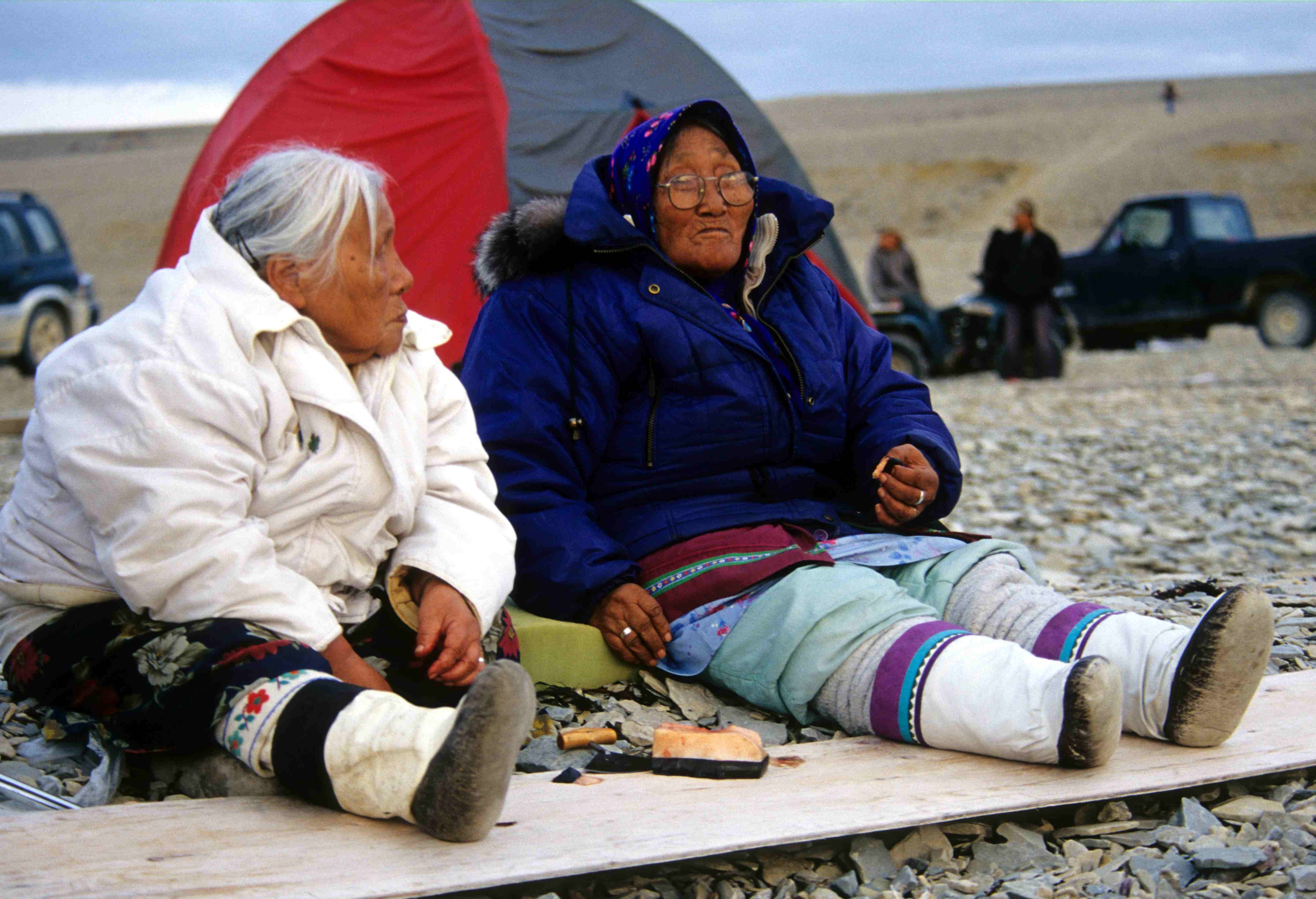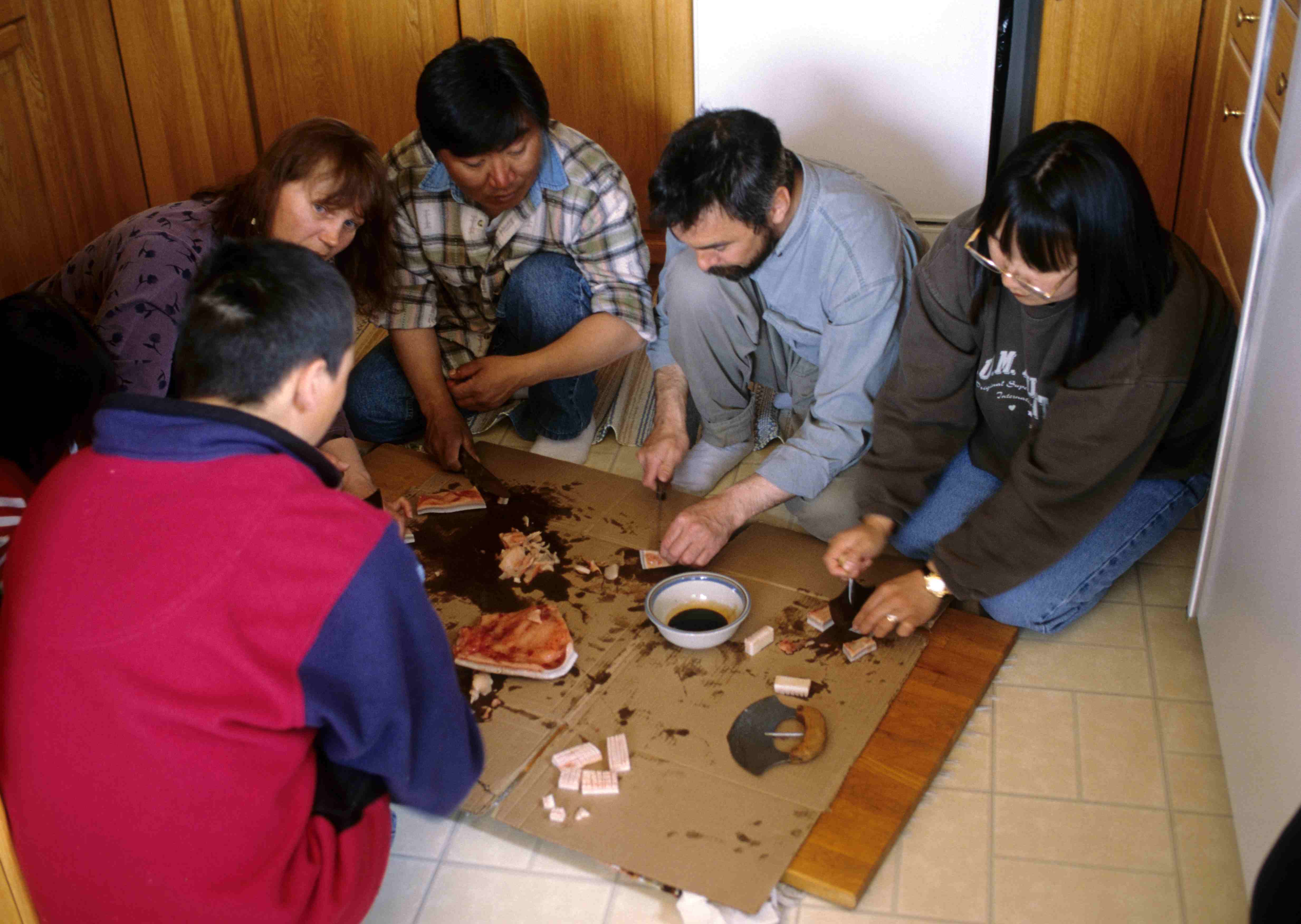Muktuk on:
[Wikipedia]
[Google]
[Amazon]
 Muktuk (transliterated in various ways, see below) is a traditional food of
Muktuk (transliterated in various ways, see below) is a traditional food of

 In Greenland, muktuk (''mattak'') is sold commercially to fish factories, and in Canada (''muktaaq'') to other communities.
When chewed raw, the blubber becomes oily, with a nutty taste; if not diced, or at least serrated, the skin is quite rubbery.
One account of a 21st-century indigenous whale hunt describes the skin and blubber eaten as a snack while the rest of the whale meat is butchered ( flensed) for later consumption. When boiled, this snack is known as ''unaaliq''. Raw or cooked, the blubber and skin are served with HP Sauce, a British condiment, or
In Greenland, muktuk (''mattak'') is sold commercially to fish factories, and in Canada (''muktaaq'') to other communities.
When chewed raw, the blubber becomes oily, with a nutty taste; if not diced, or at least serrated, the skin is quite rubbery.
One account of a 21st-century indigenous whale hunt describes the skin and blubber eaten as a snack while the rest of the whale meat is butchered ( flensed) for later consumption. When boiled, this snack is known as ''unaaliq''. Raw or cooked, the blubber and skin are served with HP Sauce, a British condiment, or
Yup'ik Eskimo Dictionary, 2nd edition
. Alaska Native Language Center. * Mungtuk, Siberian Yupik * Kimaq, Alutiiq (Sugpiaq) In some dialects, such as Inuinnaqtun, the word ''muktuk'' refers only to the edible parts of the whale's skin and not to the blubber.
 Muktuk (transliterated in various ways, see below) is a traditional food of
Muktuk (transliterated in various ways, see below) is a traditional food of Inuit
Inuit (singular: Inuk) are a group of culturally and historically similar Indigenous peoples traditionally inhabiting the Arctic and Subarctic regions of North America and Russia, including Greenland, Labrador, Quebec, Nunavut, the Northwe ...
and other circumpolar peoples, consisting of whale
Whales are a widely distributed and diverse group of fully Aquatic animal, aquatic placental mammal, placental marine mammals. As an informal and Colloquialism, colloquial grouping, they correspond to large members of the infraorder Cetacea ...
skin and blubber
Blubber is a thick layer of Blood vessel, vascularized adipose tissue under the skin of all cetaceans, pinnipeds, penguins, and sirenians. It was present in many marine reptiles, such as Ichthyosauria, ichthyosaurs and plesiosaurs.
Description ...
. A part of Inuit cuisine, it is most often made from the bowhead whale, although the beluga and the narwhal are also used. It is usually consumed raw, but can also be eaten frozen, cooked, or pickled.
Methods of preparation

 In Greenland, muktuk (''mattak'') is sold commercially to fish factories, and in Canada (''muktaaq'') to other communities.
When chewed raw, the blubber becomes oily, with a nutty taste; if not diced, or at least serrated, the skin is quite rubbery.
One account of a 21st-century indigenous whale hunt describes the skin and blubber eaten as a snack while the rest of the whale meat is butchered ( flensed) for later consumption. When boiled, this snack is known as ''unaaliq''. Raw or cooked, the blubber and skin are served with HP Sauce, a British condiment, or
In Greenland, muktuk (''mattak'') is sold commercially to fish factories, and in Canada (''muktaaq'') to other communities.
When chewed raw, the blubber becomes oily, with a nutty taste; if not diced, or at least serrated, the skin is quite rubbery.
One account of a 21st-century indigenous whale hunt describes the skin and blubber eaten as a snack while the rest of the whale meat is butchered ( flensed) for later consumption. When boiled, this snack is known as ''unaaliq''. Raw or cooked, the blubber and skin are served with HP Sauce, a British condiment, or soy sauce
Soy sauce (sometimes called soya sauce in British English) is a liquid condiment of China, Chinese origin, traditionally made from a fermentation (food), fermented paste of soybeans, roasted cereal, grain, brine, and ''Aspergillus oryzae'' or ''A ...
.
Nutrients and health concerns
Muktuk has been found to be a good source ofvitamin C
Vitamin C (also known as ascorbic acid and ascorbate) is a water-soluble vitamin found in citrus and other fruits, berries and vegetables. It is also a generic prescription medication and in some countries is sold as a non-prescription di ...
, the epidermis
The epidermis is the outermost of the three layers that comprise the skin, the inner layers being the dermis and Subcutaneous tissue, hypodermis. The epidermal layer provides a barrier to infection from environmental pathogens and regulates the ...
containing up to per . It was used as an antiscorbutic by British Arctic explorers. Blubber is also a source of vitamin D
Vitamin D is a group of structurally related, fat-soluble compounds responsible for increasing intestinal absorption of calcium, magnesium, and phosphate, along with numerous other biological functions. In humans, the most important compo ...
.
'' Proceedings of the Nutrition Society'' stated in the 1950s that:
Contaminants from the industrialised world have made their way to the Arctic marine food web. This poses a health risk to people who eat "country food" ( traditional Inuit foodstuffs). As whales grow, mercury accumulates in the liver, kidney, muscle, and blubber, and cadmium settles in the blubber, the same process that makes mercury in fish a health issue for humans. Whale meat also bioaccumulates carcinogens such as PCBs, chemical compounds that damage human nervous, immune and reproductive systems, and a variety of other contaminants.
Consumption of muktuk has also been associated with outbreaks of botulism
Botulism is a rare and potentially fatal illness caused by botulinum toxin, which is produced by the bacterium ''Clostridium botulinum''. The disease begins with weakness, blurred vision, Fatigue (medical), feeling tired, and trouble speaking. ...
.
Spellings
Transliteration
Transliteration is a type of conversion of a text from one script to another that involves swapping letters (thus '' trans-'' + '' liter-'') in predictable ways, such as Greek → and → the digraph , Cyrillic → , Armenian → or L ...
s of "muktuk", and other terms for the skin and blubber, include:
* Ikiilgin, Chukchi
* Maktaaq (ᒪᒃᑖᖅ), Sallirmiutun (Siglitun), Kivalliq, Aivilingmiutut (Aivilik), North Baffin, East Baffin, South Baffin
* Maktak (ᒪᒃᑕᒃ), Iñupiaq, Sallirmiutun, North Baffin
* Maktaq, Inuinnaqtun, Natsilingmiutut ( Inuvialuktun)
* Mattak, Labrador
Labrador () is a geographic and cultural region within the Canadian province of Newfoundland and Labrador. It is the primarily continental portion of the province and constitutes 71% of the province's area but is home to only 6% of its populatio ...
, Greenland
Greenland is an autonomous territory in the Danish Realm, Kingdom of Denmark. It is by far the largest geographically of three constituent parts of the kingdom; the other two are metropolitan Denmark and the Faroe Islands. Citizens of Greenlan ...
* Mangtak, Alaskan YupʼikJacobson, Steven A. (2012)Yup'ik Eskimo Dictionary, 2nd edition
. Alaska Native Language Center. * Mungtuk, Siberian Yupik * Kimaq, Alutiiq (Sugpiaq) In some dialects, such as Inuinnaqtun, the word ''muktuk'' refers only to the edible parts of the whale's skin and not to the blubber.
See also
* Nalukataq, spring whaling festival * Marine mammals as food * Chukchi cuisineReferences
External links
* {{World Eskimo Indian Olympics Inuit cuisine Chukchi cuisine Yakut cuisine Whale dishes Animal fat products Canadian cuisine Canadian seafood dishes Alaskan cuisine Greenlandic cuisine Traditional meat processing